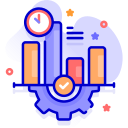Finding Bottlenecks with Data-Driven Discovery
Instrument each step with timestamps, queue sizes, and handoff counts to expose where time and attention actually vanish. Use simple trackers from scanners or tickets to compare cycle time, wait time, and rework. When people can see the full journey, the real constraint usually surprises everyone.
Finding Bottlenecks with Data-Driven Discovery
Group issues by impact and frequency, then let the 80/20 rule guide your focus toward the few recurring problems causing most of the delay. Quantify lost hours, defects, and retries. Share your top three bottlenecks with the team or in the comments, and pressure-test assumptions with real numbers.
Finding Bottlenecks with Data-Driven Discovery
A warehouse team blamed slow picking on shelf layout, but scanner logs showed delays clustered at packing due to relabeling. A quick label redesign and a checklist reduced relabeling by half and cut average order time by minutes. The fix was cheap, the data was clear, and morale jumped immediately.
Finding Bottlenecks with Data-Driven Discovery
Lorem ipsum dolor sit amet, consectetur adipiscing elit. Ut elit tellus, luctus nec ullamcorper mattis, pulvinar dapibus leo.







